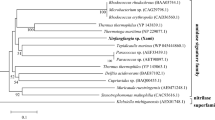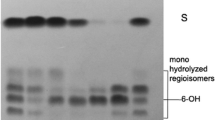Abstract
A constitutively expressed thermoactive amidase from the thermophilic actinomycete Pseudonocardia thermophila was purified to homogeneity by applying hydrophobic interaction, anion exchange and gel filtration chromatography, giving a yield of 26% and a specific activity of 19.5 units mg−1. The purified enzyme has an estimated molecular mass of 108 kDa and an isoelectric point of 4.2. The amidase is active at a broad pH range (pH 4–9) and temperature range (40–80°C) and has a half-life of 1.2 h at 70°C. Inhibition of enzyme activity was observed in the presence of metal ions, such as Co2+, Hg2+, Cu2+, Ni2+, and thiol reagents. The amidase has a broad substrate spectrum, including aliphatic, aromatic and amino acid amides. The presence of a double bond or a methyl group near the carboxamide group of aliphatic and amino acid amides enhances the enzymatic activity. Among aromatic amides with substitutions at the o-, m-, or p-position, the p-substituted amides are the preferred substrates. The highest acyl transferase activity was detected with hexanoamide, isobutyramide and propionamide. The K m values for propionamide, methacrylamide, benzamide and 2-phenylpropionamide are 7.4, 9.2, 4.9 and 0.9 mM, respectively. The amidase is highly S-stereoselective for 2-phenylpropionamide; and the racemic amide was converted to the corresponding S-acid with an enantiomeric excess of >95% at 50% conversion of the substrate. In contrast, the d,l-tryptophanamide and d,l-methioninamide were converted to the corresponding d,l-acids at the same rate. This thermostable enzyme represents the first reported amidase from a thermophilic actinomycete.




Similar content being viewed by others
References
d’Abusco AS, Ammendola S, Scandurra R, Politi L (2001) Molecular and biochemical characterization of the recombinant amidase from hyperthermophilic archaeon Sulfolobus solfataricus. Extremophiles 5:183–192
Alcantara A-R, Sanchez-Montero JM, Sinisterra JV (2000) Chemoenzymatic preparation of enantiomerically pure S(+)-2-arylpropionic acids with anti-inflammatory activity. In: Patel RN (ed) Stereoselective biocatalysis. Dekker, New York, pp 659–702
Arcus C, Kenyon J (1939) The mechanism of the Hofman reaction. Retention of optical activity during the reaction with (+)-hydratopamide. J Chem Soc 916–920
Baek DH, Song JJ, Lee SG, Kwon SJ, Asano Y, Sung MH (2003) New thermostable d-methionine amidase from Brevibacillus borstelensis BCS-1 and its application for d-phenylalanine production. Enzyme Microb Technol 32:131–139
Bhalla T, Kumar J, Kumar H, Agrawal HO (1997) Amidase production by Rhodococcus sp. NHB-2. Sci Lett 11–12:139–142
Boshoff H, Mizrahi V (1998) Purification, gene cloning, targeted knockout, overexpression, and biochemical characterization of the major pyrazinamidase from Mycobacterium smegmatis. J Bacteriol 180:5809–5814
Bradford MM (1976) A rapid and sensitive method for the quantitation of microgram quantities of protein utilizing the principle of protein-dye binding. Anal Biochem 72:248–254
Chebrou H, Bigey F, Arnaud A, Galzy P (1996) Study of the amidase signature group. Biochim Biophys Acta 1298:285–293
Cheong T, Oriel PJ (2000) Cloning of a wide-spectrum amidase from Bacillus stearothermophilus BR388 in Escherichia coli and marked enhancement of amidase expression using directed evolution. Enzyme Microb Technol 26:152–158
Ciskanik L, Wilczek JM, Fallon RD (1995) Purification and characterization of an enantioselective amidase from Pseudomonas chlororaphis B23. Appl Environ Microbiol 61:998–1003
Egorova KV, Trauthwein H, Antranikian G (2002) A rapid and sensitive method for the detection of amidases in polyacrylamide gels and agar plates. German patent 10233686.5
Fournand D, Arnaud A, Galzy P (1998a) Study of the acyl transfer activity of a recombinant amidase overproduced in an Escherichia coli strain. Application for short-chain hydroxamic acid and acid hydrazide synthesis. J Mol Catal 4:77–90
Fournand D, Bigey F, Arnaud A (1998b) Acyl transfer activity of an amidase from Rhodococcus sp. strain R312: formation of a wide range of hydroxamic acids. Appl Environ Microbiol 64:2844–2852
Fraser JA, Davis MA, Hynes MJ (2002) The genes gmdA, encoding an amidase, and bzuA, encoding a cytochrome P450, are required for benzamide utilization in Aspergillus nidulans. Exp Mycol 2:135–146
Gilligan T, Yamada H, Nagasawa T (1993) Production of S-(+)-2-phenylpropionic acid from (R,S)-2-phenylpropionitrile by the combination of nitrile hydratase and stereoselective amidase in Rhodococcus equi TG328. Appl Microbiotechnol 6:720–725
Hermes H, Tandler RF, Sonke T, Dijkhuizen L, Meijer EM (1994) Purification and characterization of an l-amino amidase from Mycobacterium neoaurum ATCC 25795. Appl Environ Microbiol 1:153–159
Hirrlinger B, Stolz A (1997) Formation of a chiral hydroxamic acid with an amidase from Rhodococcus erythropolis MP50 and subsequent chemical rearrangement to a chiral amine. Appl Environ Microbiol 9:3390–3393
Hirrlinger B, Stolz A, Knackmuss HJ (1996) Purification and properties of an amidase from Rhodococcus erythropolis MP50 which enantioselectively hydrolyzes 2-arylpropionamides. J Bacteriol 178:3501–3507
Joeres U, Kula MR (1994) Purification and characterisation of a microbial l-carnitine amidase. Appl Microbiol Biotechnol 40:606–610
Kakeya H, Sakai N, Sugai T, Ohta H (1991) Microbial hydrolysis as a potent method for the preparation of optically active nitriles, amides and carboxylic acids. Tetrahedron Lett 32:1343–1346
Kamphuis J, Boesten WHJ, Kaptein B, Hermes HFM, Sonke T, Broxterman QB, Tweel WJJ van den, Schoemaker HE (1992) The production and uses of optically pure natural and unnatural amino acids. In: Collins AN, Sheldrake GN, Crosby J (eds) Chirality in industry: the commercial manufacture and applications of optically active compounds. Dekker, New York, pp 187–208
Kobayashi M, Komeda H, Nagasawa T, Nishiyama M, Horinouchi S, Beppu T, Yamada H, Shimizu S (1993) Amidase coupled with low-molecular-mass nitrile hydratase from Rhodococcus rhodochrous J1. Sequencing and expression of the gene and purification and characterization of the gene product. Eur J Biochem 217:327–336
Komeda H, Asano Y (2000) Gene cloning, nucleotide sequencing, and purification and characterization of the d-stereospecific amino-acid amidase from Ochrobactrum anthropi SV3. Eur J Biochem 267:2028–2035
Kotlova E, Chestukhina GG, Astaurova OB, Leonova TE, Yanenko AS, Debabov VG (1999) Isolation and primary characterization of an amidase from Rhodococcus rhodochrous. Biochemistry (Mosc) 64:384–389
Krieg L, Ansorge-Schumacher MB, Kula MR (2002) Screening for amidases: isolation and characterisation of a novel d-amidase from Variovorax paradoxus. Adv Synth Catal 344:965–973
Labahn J, Neumann S, Buldt G, Kula MR, Granzin J (2002) An alternative mechanism for amidase signature enzymes. J Mol Biol 322:1053–1064
Laemmli U (1970) Cleavage of structural proteins during the assembly of the head of bacteriophage T4. Nature 227:680–685
Layh N, Hirrlinger B, Stolz A, Knackmuss HJ (1997) Enrichment strategies for nitrile-hydrolysing bacteria. Appl Microbiol Biotechnol 47:668–674
Mayaux J, Cerebelaud E, Soubrier F, Faucher D, Petre D (1990) Purification, cloning, and primary structure of an enantiomer-selective amidase from Brevibacterium sp. strain R312: structural evidence for genetic coupling with nitrile hydratase. J Bacteriol 172:6764–6773
Mayaux J, Cerbelaud E, Soubrier F, Yeh P, Blanche F, Petre D (1991) Purification, cloning, and primary structure of a new enantiomer-selective amidase from a Rhodococcus strain: structural evidence for a conserved genetic coupling with nitrile hydratase. J Bacteriol 173:6694–6704
Nawaz M, Davis JW, Wolfram JH, Chapatwala KD (1991) Degradation of organic cyanides by Pseudomonas aeruginosa. Appl Biochem Biotechnol 28/29:865–875
Nawaz M, Khan AA, Seng JE, Leakey JE, Siitonen PH, Cerniglia CE (1994) Purification and characterization of an amidase from an acrylamide-degrading Rhodococcus sp. Appl Environ Microbiol 60:3343–3348
Nawaz M, Khan AA, Bhattacharayya D, Siitonen PH, Cerniglia CE (1996) Physical, biochemical, and immunological characterization of a thermostable amidase from Klebsiella pneumoniae NCTR 1. J Bacteriol 178:2397–2401
Neumann S, Kula MR (2002) Gene cloning, overexpression and biochemical characterization of the peptide amidase from Stenotrophomonas maltophilia. Appl Microbiol Biotechnol 58:773–780
Ozaki A, Kawasaki H, Yagasaki M, Hashimoto Y (1992) Enzymatic production of d-alanine from d,l-alaninamide by novel d-alaninamide specific amide hydrolase. Biosci Biotechnol Biochem 56:1980–1984
Silman N, Carver MA, Jones CW (1991) Directed evolution of amidase in Methylophilus methylotrophus: purification and properties of amidases from wild-type and mutant strain. J Gen Microbiol 13:169–178
Skouloubris S, Labigne A, De Reuse H (1997) Identification and characterization of an aliphatic amidase in Helicobacter pylori. Mol Microbiol 25:989–998
Sonke T, Kaptein B, Boesten WHJ, Boxterman QB, Schoemaker HE, Kamphuis J, Formaggio F, Toniolo C, Rutjes FP (2000) Aminoamidase-catalyzed preparation and further transformations of enantiopure a-hydrogen and a,a-disubstituted a-amino acids. In: Ronda P (ed) Stereoselective biocatalysis. Dekker, New York, pp 23–58
Trott S, Bauer R, Knackmuss HJ, Stolz A (2001) Genetic and biochemical characterization of an enantioselective amidase from Agrobacterium tumefaciens strain d3. Microbiology 147:1815–1824
Webster N, Ramsden DK, Hughes J (2001) Comparative characterization of two Rhodococcus species as potential biocatalysts for ammonium acrylate production. Biotechnol Lett 23:95–101
Yamaki T, Oikawa T, Ito K, Nakamura T (1997) Cloning and sequencing of a nitrile hydratase gene from Pseudonocardia thermophila JCM3095. J Ferment Bioeng 83:474–477
Yamamoto K, Otsubo K, Matsuo A, Hayashi T, Fujimatsu I, Komatsu KI (1996) Production of R-(−)-ketoprofen from an amide compound by Comamonas acidovorans KPO-2771-4. Appl Environ Microbiol 1:152–155
Acknowledgements
We gratefully acknowledge the technical help of Mrs. N. Rudolph and the financial support of the Fonds der Chemischen Industrie.
Author information
Authors and Affiliations
Corresponding author
Rights and permissions
About this article
Cite this article
Egorova, K., Trauthwein, H., Verseck, S. et al. Purification and properties of an enantioselective and thermoactive amidase from the thermophilic actinomycete Pseudonocardia thermophila . Appl Microbiol Biotechnol 65, 38–45 (2004). https://doi.org/10.1007/s00253-004-1607-5
Received:
Accepted:
Published:
Issue Date:
DOI: https://doi.org/10.1007/s00253-004-1607-5




